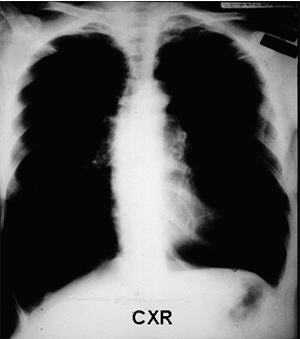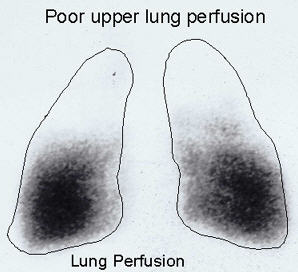Lung Volume Reduction Surgery
Surgery for Emphysema
Emphysema
Emphysema is a chronic, progressive condition which affects 2.0 million Americans. It is a disease of the lungs most commonly caused by smoking. Generally it is a breakdown in the walls of the air sacs of the lung causing them to become abnormally enlarged. These abnormally enlarged air sacs function poorly for oxygenation.

above: Hyperexpansion from Ephysema
In addition, they cause the small airways which carry the air to and from the air sacs to collapse during breathing; especially exhalation. These abnormally enlarged air sacs fill easily with air during inspiration but they lose their ability to empty the lung through the small airways during exhalation. This resembles airways obstruction which is why some use the term chronic obstructive pulmonary disease to describe emphysema. The problem of easy filling and poor emptying of the lung leads to progressive hyperexpansion of the lungs resulting in inefficient breathing mechanics. This in addition to the poor oxygenating capability of emphysema lungs makes it more and more difficult to breathe.

Lung Volume Reduction Surgery
Many people who suffer with emphysema have portions of the lung which are more affected than others. This finding led to the development of a surgical approach to treat emphysema. Lung volume reduction surgery (LVRS) is a procedure which removes approximately 20-35% of the poorly functioning, space occupying lung tissue from each lung. By reducing the lung size, the remaining lung and surrounding muscles (intercostals and diaphragm) are able to work more efficiently. This makes breathing easier and helps patients achieve greater quality of life.
Good Candidates
It is very important that this operation is only offered to people who are likely to benefit from the procedure with the lowest risk of complications. A good candidate for LVRS is someone who has stopped smoking for at least 4 months and has disabling emphysema despite complete compliance with optimum medical therapy. The patient must be able to participate in a pulmonary rehabilitation program prior to and after surgery. Any other medical conditions that the candidate may have must be well controlled and must not present unacceptable risks for complications from the procedure. Most importantly, the patient must have a pattern of emphysema that is amenable to surgical management. This means that there are space occupying, poorly functioning areas of the lung which can be removed to improve lung function. Imaging studies including chest x-ray, CAT scan, and lung perfusion studies are done to determine this.
The National Emphysema Treatment Trial (NETT) was a prospective, randomized, multicenter trial which compared the results of LVRS to medical therapy which showed that there were 3 groups of patients that tend to benefit from LVRS. The following groups of patients are candidates for LVRS:
Group 1: Patients with predominantly upper lobe emphysema and low exercise capacity. These patients have improved survival and functional outcomes after LVRS compared to medical therapy.
Group 2: Patients with predominantly upper lobe emphysema and high exercise capacity. These patients have improved functional outcomes after LVRS but no difference in survival compared to medical therapy.
Group 3: Patients with non-upper lobe emphysema and low exercise capacity. These patients have improved survival after LVRS but no difference in survival compared to medical therapy.
Poor Candidates
The NETT also identified patients who are unlikely to benefit from LVRS and have high risk for death after the procedure. The following groups of patients are not candidates for LVRS:
- Patients with non-upper lobe emphysema and high exercise capacity.
- Patients with extremely poor pulmonary function (FEV1 20% or less than predicted) and either homogenous distribution of emphysema on CT scan or extremely poor carbon monoxide diffusing capacity (DLCO 20% or less than predicted).
What to Expect
To optimize exercise capacity and improve early postoperative recovery, patients must participate in a 6 to 10 week pulmonary rehabilitation program prior to surgery. The operation requires general anesthesia and can be done through either a breast bone incision or smaller chest incisions using video surgery. A special surgical stapler is used to remove the diseased lung tissue and seal the remaining lung from leaking blood and air. Immediately after the procedure patients are awakened from the general anesthetic and allowed to breath on their own. Pain medicine is given through an epidural catheter to help control postoperative discomfort. Drainage tubes are left in the chest to drain any excess air or fluid from the chest after surgery. These are removed once the air and fluid leakage stops. Physical therapy is reinstituted early during the recovery phase during the hospitalization. Patients are discharged from the hospital once the patient is mobile, tolerating a regular diet and drainage tubes have been removed.
Anticipated Benefits
- Relief of shortness of breath
- Improved lung function
- Increased energy level and physical mobility
- Improved ability to function at normal daily activities
- May decrease need for supplemental oxygen
Potential Complications
There are significant risks associated with LVRS because of the poor baseline lung function. The major risks associated with this procedure are:
- Prolonged air leakage is the most common complication after LVRS. Approximately 40% of patients will have this problem. Some patients will actually go home with a chest drain in place for a few days to help manage this.
- Pneumonia (15%) can occur in emphysema patients, especially in patients who have a history of recurrent bouts
- Bleeding (2-5%)
- Stroke (<1%)
- Heart attack (1%)
- Death: The chance of dying after LVRS is approximately 3-8%
How to be evaluated for LVRS
Anyone who meets the general criteria can be considered for a formal evaluation. This would involve a thorough review of the patient’s medical history, physical exam, pulmonary function studies, and imaging studies. If these preliminary studies meet the required criteria, further evaluations will be performed as necessary. Once all necessary information has been assembled, the patient will then be discussed in the Cardiothoracic Surgery Lung Failure Management Conference to discuss whether LVRS should be offered to the patient. In some cases patients may be considered better candidates for lung transplantation; which would be offered in those instances.
